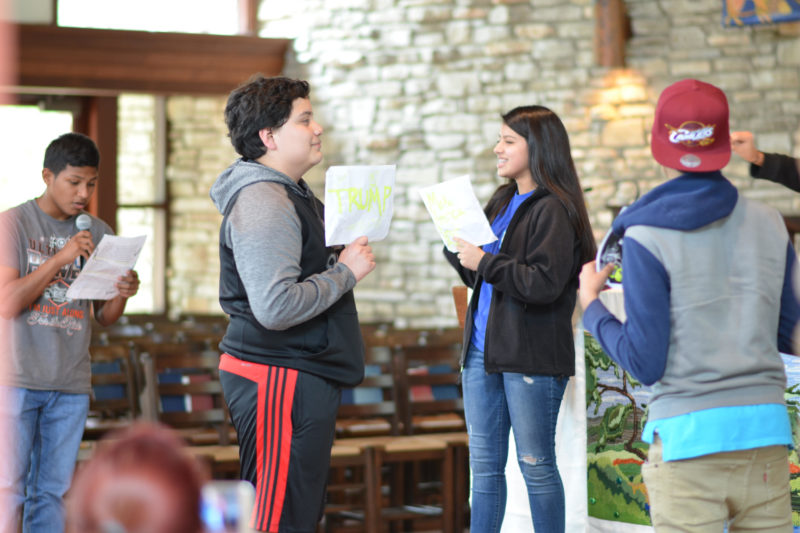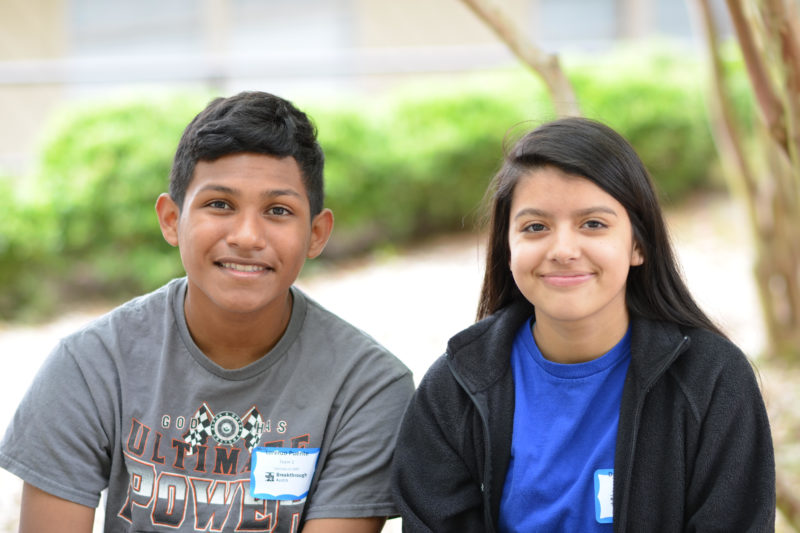AmeriCorps Cuts Would Hurt Nonprofit for Low-Income Students
By Louise Rodriguez
Reporting Texas

Daniela Herrera, right, is a Breakthrough student who credits her mother for encouraging her to sign up for the program. She recently attended an informational session at St. Stephen’s Episcopal School. Louise Rodriguez/Reporting Texas
Lunchtime had ended at Del Valle Elementary School, but about six dozen boys and girls sat waiting at two long rows of cafeteria tables. They were about to hear a pitch that could change their lives.
Breakthrough Central Texas representatives were visiting that day in April to encourage rising sixth-graders to sign up for a program that prepares low-income students to be the first in their families to attend college.
Jessica Vanover, an AmeriCorps senior leader for Breakthrough, got the students’ attention with her opening question: “Who here wants to go to college?”
Hands shot up. Vanover asked what schools they had in mind.
“Harvard,” called out the first student. Another said Stanford, and many mentioned the University of Texas at Austin. One boy with a buzz cut made the “Hook’em Horns” hand sign.
“All those schools are great and hopefully Breakthrough can help you get there,” Vanover said.
Vanover, 23, a graduate of UT’s College of Education, and other Breakthrough staffers walked the students through the steps required to become part of the program, including writing a personal essay and participating in a screening interview.
The Del Valle students were on their way to committing to an intensive, 12-year program that provides low-income students both academic support and the social and emotional support needed to navigate the journey from middle school through college graduation.
Since 2011, Breakthrough Central Texas has relied on AmeriCorps volunteers and staff such as Vanover to mentor students throughout the school year in the Austin and Manor school districts.
Breakthrough started in 2001 with 41 students and now serves over 1,200 at one time, investing just over $2,000 per year on each student. With the addition of Del Valle Independent School District, the program expects the number to grow to 1,450 students, with a goal of helping nearly 2,300 students by 2021.
Eighty-seven percent of Breakthrough students are from low-income families; 97 percent are minorities; 58 percent speak a language other than English at home.
President Donald Trump has proposed ending funding for AmeriCorps for fiscal 2018, meaning nationwide organizations that rely on the community service program could be scrambling to fill voids or reducing staff by next year. Breakthrough would lose $710,000, or 17 percent of its annual budget.
Breakthrough plans to take on 150 AmeriCorps interns for six weeks this summer to teach students from the Austin, Manor and Del Valle districts at campuses around Austin, including at UT. The program currently employs nine AmeriCorps staff and hopes to increase that to 14 next school year.
Liz Darling, CEO and president of OneStar Foundation, the Texas agency that distributes AmeriCorps money to local programs, including Breakthrough, predicted a “real debate” in Congress on next year’s federal budget.
“If there was a significant reduction or elimination (in funding), it would drastically affect those programs that depend heavily upon AmeriCorps members,” Darling said.

Breakthrough students Lorenzo Lee Puente, 14, and Daniela Herrera, 13, take a break from preparing for their presentation at St. Stephen’s. Louise Rodriguez/Reporting Texas
The Del Valle district will send its first students to Breakthrough camp this summer for tutoring. However, it’s unlikely that Breakthrough could add more districts if AmeriCorps resources were no longer available, according to Michael Griffith, Breakthrough’s executive director.
“It would critically impact our ability to function,” he said. “It would make the opportunity for us to expand to another school district, or to serve more students beyond what we’ve committed to, impossible.”
AmeriCorps grants also allow Breakthrough to provide modest annual stipends to employees such as Vanover, along with an end-of-year award of just over $5,000.
Breakthrough helps students overcome barriers to their success, such as failing grades, goal confusion, homelessness, mental health or abuse. School transitions, especially the step from middle school to high school, are the most challenging times. But Griffith said Breakthrough’s advocates stick with students through their personal ups and downs, providing them with constant one-on-one advising at school and at home.
“It’s a commitment. We’re going to be there, even when they say, ‘I’ve got this figured out on my own,’” Griffith said.
As students enter high school, the program emphasizes leadership, so that students develop self-advocacy skills, such as asking for help, setting goals and sticking up for themselves. Breakthrough also sends students to internships at companies such as Bazaarvoice and Samsung.
Since 2008, 99 percent of Breakthrough participants have graduated from high school on time, compared to an average of 84 percent for low-income students and 89 percent overall in Central Texas, and the program’s retention rate is 92 percent.
At that point, mentors step in to help students figure out the complexities of campus life, such as financial aid and housing, and making sure they persist and earn their degrees. As the first Breakthrough students are just completing college, there is no data yet on graduation rates.
Austin ISD students Daniela Herrera, 13, and Lorenzo Lee Puente, 14, said Breakthrough allows them to be good students and to work in a challenging academic environment.
Both were among a group of middle school students who took part in Breakthrough’s Living Newspaper, a series of skits examining current social justice issues, such as immigration and bathroom bills, at St. Stephen’s Episcopal School in West Lake Hills. The collaboration between Breakthrough and St. Stephen’s students, which happens six Saturdays a year, started in 2008.
Herrera’s mother encouraged her to sign up for the program.
“At first, I didn’t think it was going to be that fun,” Herrera said. “I thank my mom, because she was the one who made me apply.”
For Puente, Breakthrough keeps him focused on his goals.
“When I mess up in school, (my case worker) meets with us every Tuesday and helps us with what we need to work on in our classes,” he said. “It helps me figure out the mistakes that I made (and) I can go back and fix them.”
Program coordinator Alicia Flores, 25, is a Breakthrough alumnus, but at first was reluctant to apply to the program. To entice her, Flores’ Allison Elementary School teacher took her to one of her favorite restaurants, Alonzo’s in Montopolis, for dinner.
“I would love to say that I fell in with Breakthrough because of their mission, but I was bribed,” Flores said, laughing.
In high school, Flores said her Breakthrough mentor kept her focused on college applications, even providing stamps for mailing. “She was definitely very involved in my life.”
In the Del Valle cafeteria, Flores and others passed out pencils, paper and a worksheet with a drawing of hamburger. Each layer of the hamburger corresponded to a part of an essay – the top bun was the introduction – giving the students a way to organize what they wanted to say.
The room buzzed with the sounds of students sharing ideas with their tablemates.
Flores approached a boy named Jose who was uncertain about how to start his essay and had laid his head on the table. Flores guided him: “Do I have to know if you play sports on the weekends? What kind do you play?”
The boy sat up and said, “Soccer.”
“That’s who you are. That’s a big part of what you do on a day-to-day basis,” said Flores.
Jose read from the handout: “’Where will you be in 15 years?’” Smiling, he answered: “I will be rich! I’ll be a surgeon saving people’s lives.”
It was the start of a hopeful future—a good percentage of these children will become Del Valle ISD’s first sixth-graders to embark on the Breakthrough path
Vanover, who calls her legislators every day urging them to keep funding AmeriCorps and tells everyone she knows to do the same, hopes to be with these students all the way.